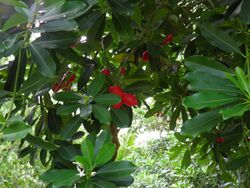Biology:Ochrosia elliptica
| Northern ochrosia | |
|---|---|

| |
| An Ochrosia elliptica in the Bahamas | |
Script error: No such module "Conservation status".
| |
| Scientific classification | |
| Kingdom: | Plantae |
| Clade: | Tracheophytes |
| Clade: | Angiosperms |
| Clade: | Eudicots |
| Clade: | Asterids |
| Order: | Gentianales |
| Family: | Apocynaceae |
| Genus: | Ochrosia |
| Species: | O. elliptica
|
| Binomial name | |
| Ochrosia elliptica | |
| Synonyms[3] | |
|
Homotypic:
Heterotypic:
| |
Ochrosia elliptica, commonly known as northern ochrosia, bloodhorn, scarlet wedge-apple, or simply ochrosia, is a tree in the dogbane family Apocynaceae native to north-eastern Australia and the southwest Pacific.[4][3][5]
Description
The northern ochrosia is a small tree growing to about 6 m (20 ft) high. The leaves are glossy dark green above and paler below, arranged in whorls of three or four, and held on petioles around 5 to 10 mm (0.20 to 0.39 in) long.[5][6] They have around 20–25 distinct secondary (lateral) veins and one or two intramarginal veins (i.e. a vein that parallels the leaf margin). The tertiary venation is obscure on the upper surface.[5][6] The leaf shape is obovate to broadly elliptic, and they measure up to 17 cm (6.7 in) long by 7 cm (2.8 in) wide.[5][6]
The flowers occur in axilliary clusters and are small, yellow/white and fragrant. They are followed by pairs of striking red fruit 5–6 cm long by 2–3 cm in diameter, which resemble elongated tomatoes or a pair of red horns. The fruits are poisonous, and plants bleed white sap copiously when wounded.[7]
Uses
The plant is harvested from the wild for local use as a medicine and source of beads.[citation needed] It is cultivated for its medicinal use in China .[citation needed] It is widely distributed as an ornamental, being valued for its startling bright red fruits and dense clusters of cream flowers that are produced throughout the year on an open spreading leafy canopy.[citation needed]
Its fruit and sap are highly poisonous.[8]
Other names
China : Gu cheng mei gui shu.
English: Berrywood tree, Bloodhorn, Elliptic yellowwood, Mangrove ochrosia, Wedge apple.[9]
References
- ↑ Rivers, M.C. (2021). "Ochrosia elliptica". IUCN Red List of Threatened Species 2021: e.T170446721A170446765. doi:10.2305/IUCN.UK.2021-1.RLTS.T170446721A170446765.en. https://www.iucnredlist.org/species/170446721/170446765. Retrieved 3 October 2023.
- ↑ "Ochrosia elliptica". Centre for Australian National Biodiversity Research, Australian Government. https://id.biodiversity.org.au/name/apni/84943.
- ↑ 3.0 3.1 3.2 "Ochrosia elliptica Labill.". Royal Botanic Gardens, Kew. 2023. https://powo.science.kew.org/taxon/urn:lsid:ipni.org:names:80500-1.
- ↑ "Species profile—Ochrosia elliptica". Queensland Government. 2022. https://apps.des.qld.gov.au/species-search/details/?id=16588.
- ↑ 5.0 5.1 5.2 5.3 "Ochrosia elliptica". Centre for Australian National Biodiversity Research (CANBR), Australian Government. 2020. https://apps.lucidcentral.org/rainforest/text/entities/Ochrosia_elliptica.htm.
- ↑ 6.0 6.1 6.2 Forster, P.I. (2022). "Ochrosia elliptica". Australian Biological Resources Study, Department of Climate Change, Energy, the Environment and Water: Canberra. https://profiles.ala.org.au/opus/foa/profile/Ochrosia%20elliptica.
- ↑ "Ochrosia elliptica". https://asianplant.net/Apocynaceae/Ochrosia_elliptica.htm.
- ↑ "Ochrasia elliptica". https://tropical.theferns.info/viewtropical.php?id=Ochrosia+elliptica.
- ↑ "Ochrosia elliptica". https://asianplant.net/Apocynaceae/Ochrosia_elliptica.htm.
Wikidata ☰ Q7076409 entry
 |


